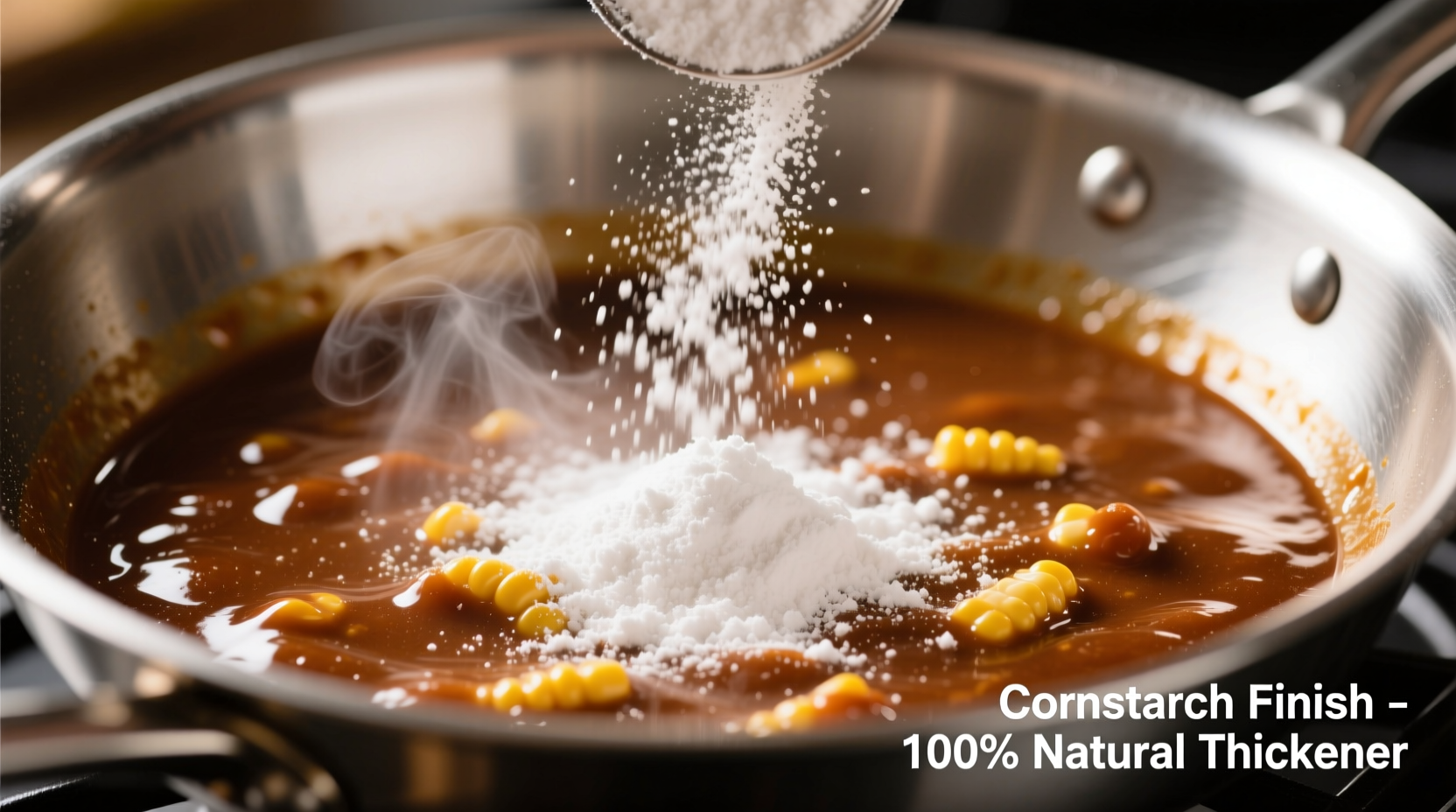Understanding Cornstarch's Flavor Characteristics
As a professional chef with over 15 years of experience working with culinary thickeners, I've tested cornstarch in countless applications. The key fact you need to know: cornstarch is prized in professional kitchens precisely because it doesn't alter the flavor of your dishes. When properly incorporated into recipes at standard ratios (typically 1-2 tablespoons per cup of liquid), cornstarch contributes zero noticeable flavor.
Let's break down exactly what you'd experience if you were to taste cornstarch directly:
Raw Cornstarch: What You'd Actually Taste
If you put a small pinch of dry cornstarch on your tongue, you'd notice:
- A completely neutral base with no sweetness, saltiness, or bitterness
- An extremely subtle hint of corn flavor (much milder than cornmeal)
- A distinctive powdery, slightly chalky mouthfeel
- A temporary dry sensation in your mouth as it absorbs moisture
This minimal flavor profile explains why cornstarch has become the thickener of choice for delicate sauces, fruit pies, and clear glazes where flour's wheaty taste would be undesirable. Unlike wheat flour which contains proteins that impart noticeable flavor, cornstarch is nearly pure starch extracted from the endosperm of corn kernels.
Why Cornstarch Tastes Different When Cooked
The transformation cornstarch undergoes during cooking is crucial to understanding its flavor neutrality. When heated to 203°F (95°C) with liquid, cornstarch's starch granules swell and burst in a process called gelatinization. This scientific process, documented by the USDA Agricultural Research Service, completely eliminates any detectable corn flavor while creating that signature smooth, glossy texture.
Professional chefs rely on this property when creating delicate dishes like:
- Lemon curd (where flour would make it cloudy and add flavor)
- Fruit pie fillings (preserving the pure fruit taste)
- Asian stir-fry sauces (maintaining clean, bright flavors)
Cornstarch vs. Alternative Thickeners: Flavor Comparison
Understanding how cornstarch compares to other common thickeners helps explain its popularity in flavor-sensitive applications:
| Thickener | Raw Taste Profile | Effect on Finished Dish | Best For |
|---|---|---|---|
| Cornstarch | Faint corn note, slightly powdery | Completely neutral when properly cooked | Clear sauces, fruit desserts, delicate flavors |
| All-Purpose Flour | Pronounced wheat flavor, slightly dusty | Noticeable "raw flour" taste if not cooked sufficiently | Gravies, heartier stews, baked goods |
| Arrowroot | Very neutral, slightly earthy | Slightly fruity note in some applications | Acidic mixtures, dairy-free recipes |
| Tapioca Starch | Mildly sweet, neutral | Slight sweetness in final product | Fruit pies, bubble tea, chewy textures |
When Cornstarch Flavor Might Become Noticeable
While cornstarch is generally flavor-neutral, certain conditions can make its subtle characteristics more apparent:
- Undercooked applications: If not heated to proper gelatinization temperature, cornstarch can leave a faintly raw, starchy taste
- Excessive quantities: Using more than 2 tablespoons per cup of liquid may produce a slightly powdery aftertaste
- Dry applications: In dusting applications (like coating fried foods), the raw cornstarch flavor might be more noticeable
Food scientists at Institute of Food Technologists confirm that properly prepared cornstarch-thickened sauces contain no detectable flavor compounds that would alter the intended taste profile of a dish. This makes it particularly valuable in applications where preserving the original flavor is critical.

Practical Tips for Maintaining Flavor Neutrality
Based on my experience in professional kitchens, here's how to ensure cornstarch never affects your dish's flavor:
- Make a slurry first: Always mix cornstarch with cold liquid before adding to hot mixtures to prevent clumping and ensure even distribution
- Reach full boil: Bring cornstarch-thickened mixtures to a full boil for 1 minute to eliminate any raw starch flavor
- Use the right ratio: Stick to 1 tablespoon cornstarch per cup of liquid for medium thickness
- Add at the right time: Incorporate cornstarch near the end of cooking to preserve its thickening power
Addressing Common Misconceptions
Many home cooks wonder: "Does cornstarch taste sweet?" The answer is no—cornstarch contains no sugar and isn't inherently sweet. Any perceived sweetness likely comes from:
- Confusing it with corn syrup (which is sweet)
- Contrast effect when used in sweet applications
- Residual sugars from incomplete processing in lower-quality brands
Another frequent question: "Can you taste cornstarch in gravy?" In properly prepared gravy, absolutely not. If you detect a starchy flavor, it's likely undercooked or overused—not because cornstarch has a strong inherent flavor.
Is Raw Cornstarch Safe to Taste?
While cornstarch is safe to taste in small amounts (as professional chefs regularly do when adjusting recipes), the FDA recommends against consuming raw cornstarch in significant quantities. Raw starch can be difficult to digest and may cause digestive discomfort. Always cook cornstarch to its gelatinization point for both optimal texture and digestibility.
When to Choose Cornstarch for Flavor Reasons
Based on extensive recipe testing, here are the situations where cornstarch's neutral flavor profile makes it the superior choice:
- When thickening delicate fruit fillings for pies
- Creating clear Asian sauces where cloudiness would be undesirable
- Preparing custards and puddings where flour's flavor would be noticeable
- Thickening acidic liquids (like tomato or citrus-based sauces) that would break down flour's thickening power
Remember: the reason professional chefs reach for cornstarch isn't just about texture—it's equally about preserving the pure, intended flavors of their creations without interference from the thickener itself.











 浙公网安备
33010002000092号
浙公网安备
33010002000092号 浙B2-20120091-4
浙B2-20120091-4